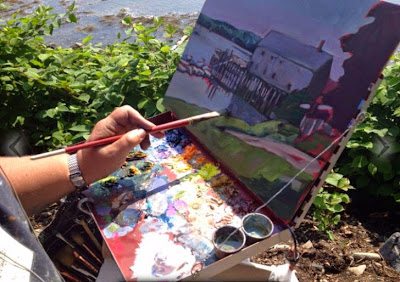
“Dyce Head in the early morning light,” 12X9, oil on canvas board, Carol L. Douglas
It’s unusual to come home from a week of painting empty-handed, but it just happened. I painted 13 works in seven days—seven at Ocean Park, six at Castine. Four are on display at Jakeman Hall in
Ocean Park for rest of the season. The others have all gone on to new homes.
Every year, tiny Castine, ME (population 1366) turns out crowds of enthusiastic art buyers for
Castine Plein Air. There are forty artists producing six works each, meaning there are 240 works on display. Somehow a majority of them get sold.

“Jonathan Submarining,” 8X6, oil on canvas board, Carol L. Douglas
As I walked into the Maine Maritime Academy student center with fellow painter
Bruce Newman, I commented that every year I think I’ve done good work until I see what my peers have done. He said he always feels the same way. Each year, new artists are juried in, so the quality is being distilled upwards. I get inquiries from enough out-of-state painters about this show that I know it’s ‘got legs’ in the
plein air community.

“Wadsworth Cove spruce,” 6X8, oil on canvas board, Carol L. Douglas
On Saturday, Castine’s
Witherle Library also held a used book sale. I have inside information about this event because my Castine hosts are the library’s president and treasurer. “There are lots of art books,” Harry told me. Sadly, the sale ended at 2, which was also our delivery deadline. Even though I finished painting earlier than I had ever done before, I still barely managed to set up on time.

“Wadsworth Cove garden,” 10X8, oil on canvas board, Carol L. Douglas
Despite my atrocious driving, I got to the library just as the signs were coming down. However, the Kaiserians took pity on me. Early Sunday morning, I went through the sale with Berna, even though I was sure Castine residents Philip Freedman and Karen Stanley had already nabbed all the best books. I found a book of
Sir Stanley Spencer paintings. This odd English artist is one of my favorite painters. Score!

“The British Canal,” 12X16, oil on canvas board, Carol L. Douglas
I sometimes think we should have bought a home in Castine instead of Rockport. It’s so darn friendly. However, every mile north is a mile farther from my kids and grandkids. At times I feel those miles keenly. Such was the case on Sunday morning.
I have two ways of fighting sleepiness while driving. The first is writing in my head, but that only works when I’m mentally awake but physically tired. So I sang scales—creaky, raspy, cat-howl vocal exercises I learned in my youth. I don’t know if I’m kept awake because they sound so bad or whether they oxygenate the brain, but they always work as a last resort. They’re especially entertaining when driving through Camden with the windows down.

“J&E Riggins and Bowdoin in Castine Harbor,” 12X9, oil on canvas board, Carol L. Douglas
The physical crash, when it comes, is terrific. I find that the only cure is sleep—lots and lots of sleep. I crawled into my bed and slept the afternoon away, missing a visit by
Mary Byrom and Marcus Gale to my studio. This morning, I feel almost perky enough to look at my calendar and see what I’m doing this week.



































